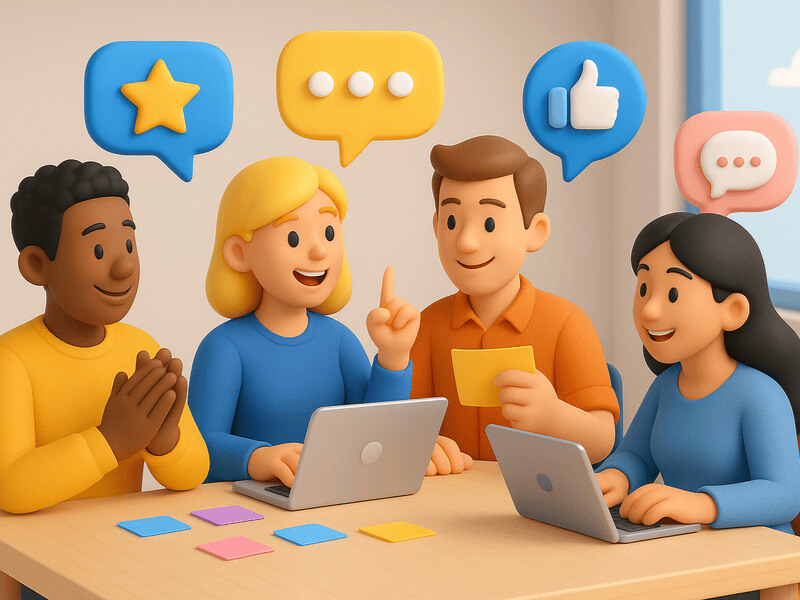
What are continuous feedback models?
One of the biggest challenges facing companies today is continuous employee engagement. Turnover rates remain high, and workplaces will need to evolve to get people excited about coming to work. Fortunately, continuous feedback models can help you accomplish this goal by making sure your employees always feel heard and valued for their contributions.
Software company Adobe, for instance, found continuous feedback to be one of the most successful ways to increase employee engagement and productivity. After implementing continuous feedback models in their workplace and changing out their old-school traditional performance management systems they saw an impressive boost in both engagement and project success rates.
Continuous feedback models are simply a series of ongoing, structured conversations that take place between managers and their employees. In these conversations, supervisors present employees with real-time feedback on a variety of factors including work quality, productivity level, and overall work satisfaction.
To get the most out of your continuous feedback model, you'll need to design a few different types of check-ins to use over the course of each year. These models are designed to assess employee engagement across a few different factors, including personal fulfillment, professional development, and expectations.
The goal is to have managers spend about 15 minutes every week delivering positive feedback by focusing on strengths versus weaknesses. There should also be equal attention paid to both individual tasks as well as this employee's role in the bigger picture.
While it may seem like a lot of extra work, high engagement and low turnover rates should be well worth the effort. Plus, employees will stay motivated and coming up with new ideas while contributing to companywide success, which means there's no telling how big Adobe could grow!
To create continuous feedback models that work, it's essential to make sure all of your employees' needs are heard. Make continuous feedback part of an employee survey or other performance management tool that lets everyone at the company give input on what they've enjoyed and where there is room for growth.
Every person who works at your company should feel comfortable giving their thoughts through continuous models, whether it's done through email, surveys, or other approaches.
Benefits of continuous feedback models
Continuous feedback is about more than just asking for employee feedback on your company's practices. It's about continuing to create a culture where every person has the opportunity to be heard. The continuous performance management process increases trust, helps with conflict resolution, and makes employees feel like they are part of something bigger.
Here are just some of the benefits of continuous feedback models:
- Increases employee engagement
- Helps create clear company culture and values
- Improves decision making skills throughout the organization
- Increases productivity by creating more open lines of communication among employees, managers, and executives.
Implementing your continuous feedback model
If you want to get started with creating your continuous feedback model, here are some suggestions for getting started.
- Identify which areas need the most improvement: You can start by asking employees what they already like about the company and where there is room for change. This ensures you won't waste time focusing on things that aren't relevant to what your employees want.
- Create a safe space: Your employees must know their feedback will be taken seriously and used to improve the company. You can do this by sending an email detailing how you'll implement continuous feedback and what to expect in your transition to a feedback culture. This way, everyone is on the same page and there are no misunderstandings.
- Start with a pilot program: Do a soft launch of a continuous feedback performance review program in one department to see how it affects the company culture before implementing the model companywide. This is an ideal way to test out different models and ensure everyone is on board.
- Incentivize participation: For your employees to be fully engaged, they will need to know that their input is valued. Consider offering small incentives for participation with the first round of feedback or asking employees who submit valuable ideas to co-author blog posts on performance appraisal. This way, everyone is working towards the same goal and knows their contributions are appreciated.
Continuous feedback models can be a great way to accomplish the goal of increasing employee engagement. By implementing a continuous feedback model with your employees and making sure everyone has a voice, you can create a workplace where people feel like they're part of something bigger and more meaningful than just their job.
More strategies for continuous feedback models
If you still feel unsure where to begin, here are a few continuous feedback strategies to keep in mind:
- Use social media: By asking for feedback via social media, you can generate far more regular feedback than you would get from an annual performance review. Effective feedback can come from anyone, and key results from the feedback process can always be summarized in a direct report.
- Keep it simple: Don't be afraid to start small and slowly implement changes over time. If the first round of feedback is overwhelming or upsetting, go back to the drawing board and modify your model. Sometimes, informal feedback and ideas drawn from meaningful conversations can be more useful than a dozen formal surveys.
- Send out a weekly email: This is an ideal way to keep employees in the loop and can be used as a guide for suggestions as well as a way to provide constructive feedback to the whole team.
- Encourage regular kudos through a program like the free Slack app Matter. Bonus: the app has an easy-to-use constructive feedback feature too! It's important to balance your criticism of employee performance with praise when something is done right.
- Find the right frequency: If you're sending too many emails asking for feedback, your employees may become annoyed. On the other hand, if you don't send any feedback requests, they'll feel like their input isn't valued, and continuous feedback will go nowhere. Finding the right medium will improve your feedback model over time.
- Use different strategies at once: If you start with one style of continuous feedback and it proves to be unsuccessful, move on to another strategy until you find what works for your company culture. This is a great way to troubleshoot any issues that may arise and improve overall results.
- Increase individual accountability: Rather than give all our performance feedback at once, you can ask employees to select one or two things they want to focus on for the week and share with you how you can help them get there. This type of performance management system will focus their learning efforts and motivate others around them to do the same.
Doing continuous feedback models right
If you're still unsure where to start with a continuous feedback program, consider implementing these strategies:
- Let employees provide input on how your model should work: By including them in the feedback loop from the beginning, they will feel as though their voices are heard and they can be more productive.
- Relay positive feedback from colleagues: If you have an environment where people feel like they're working with a team, you'll see continuous improvement and an uptick in the employee experience.
- Make feedback anonymous: If employees feel like their managers will punish them for giving constructive criticism or sharing undesirable ideas, they may not want to participate in the program. This is why it's important to make the model truly anonymous and ensure everyone feels safe and comfortable with their contributions.
Make sense? Don't worry, it'll all iron itself out over time! That's the beauty of ongoing feedback: you might make a mistake, but you won't be making it for long.
























